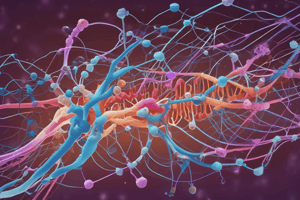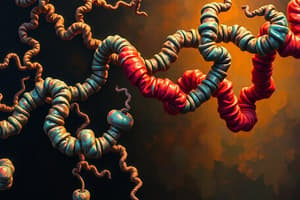Podcast
Questions and Answers
What is the primary structure of a protein?
What is the primary structure of a protein?
- Overall 3D shape of a protein
- Arrangement of multiple polypeptide chains
- Alpha helices and beta sheets
- Sequence of amino acids (correct)
Which of the following is a function of proteins in the body?
Which of the following is a function of proteins in the body?
- Storing genetic information
- Transmitting nerve impulses
- Catalyzing biochemical reactions (correct)
- Burning fat for energy
What is a complete protein?
What is a complete protein?
- A protein that is derived only from plant sources
- A protein that contains all essential amino acids (correct)
- A protein that is denatured
- A protein that is synthesized by the body
What are essential amino acids?
What are essential amino acids?
What is the role of transcription in protein synthesis?
What is the role of transcription in protein synthesis?
Which type of dietary source is primarily considered to provide high-quality protein?
Which type of dietary source is primarily considered to provide high-quality protein?
What happens during the denaturation of proteins?
What happens during the denaturation of proteins?
What is the recommended percentage of total daily calories that should come from protein?
What is the recommended percentage of total daily calories that should come from protein?
Flashcards are hidden until you start studying
Study Notes
Definition
- Proteins are large, complex molecules made up of amino acids.
- They play crucial roles in the body, including structural, functional, and regulatory functions.
Structure
- Composed of long chains of amino acids linked by peptide bonds.
- Levels of structure:
- Primary: Sequence of amino acids.
- Secondary: Alpha helices and beta sheets formed by hydrogen bonding.
- Tertiary: Overall 3D shape of a single protein molecule.
- Quaternary: Arrangement of multiple polypeptide chains.
Functions
- Enzymatic: Catalyze biochemical reactions (e.g., digestive enzymes).
- Structural: Provide support and shape (e.g., collagen in connective tissues).
- Transport: Carry substances (e.g., hemoglobin transports oxygen).
- Hormonal: Serve as hormones regulating physiological processes (e.g., insulin).
- Immune response: Antibodies help fight infections.
Sources
- Animal sources: Meat, fish, eggs, dairy.
- Plant sources: Legumes, nuts, seeds, whole grains.
Amino Acids
- 20 standard amino acids are the building blocks of proteins.
- Essential amino acids must be obtained from the diet; non-essential can be synthesized by the body.
Protein Synthesis
- Occurs in two main stages:
- Transcription: DNA is transcribed to mRNA in the nucleus.
- Translation: mRNA is translated into a protein at the ribosome.
Dietary Recommendations
- Recommended dietary allowance (RDA) varies by age, sex, and activity level.
- General guideline: Approximately 10-35% of total daily calories should come from protein.
Health Considerations
- Protein quality is determined by the amino acid profile and digestibility.
- High-protein diets can support weight loss and muscle building but may have risks if excessively consumed, especially from animal sources.
- Certain populations may require protein restrictions (e.g., those with kidney disease).
Key Terms
- Peptide bond: A covalent bond linking amino acids.
- Denaturation: The process of proteins losing their structure due to external factors (e.g., heat, pH changes).
- Complete protein: Contains all essential amino acids (e.g., animal proteins, soy).
Conclusion
- Proteins are essential macromolecules vital for various bodily functions, requiring a balanced dietary intake to maintain health.
Definition
- Proteins are large, complex molecules formed from amino acids.
- They serve essential roles such as structural, functional, and regulatory functions in the body.
Structure
- Composed of long chains of amino acids connected by peptide bonds.
- Levels of structure include:
- Primary: Linear sequence of amino acids.
- Secondary: Formation of alpha helices and beta sheets through hydrogen bonding.
- Tertiary: The unique three-dimensional shape of a single protein molecule.
- Quaternary: The arrangement of multiple polypeptide chains into a functional protein.
Functions
- Enzymatic: Proteins like digestive enzymes catalyze biochemical reactions.
- Structural: Proteins provide support and shape, such as collagen in connective tissues.
- Transport: Proteins like hemoglobin are crucial for carrying oxygen in the bloodstream.
- Hormonal: Proteins function as hormones, such as insulin, regulating bodily processes.
- Immune response: Antibodies are proteins that help combat infections.
Sources
- Animal sources: Include meat, fish, eggs, and dairy products.
- Plant sources: Comprise legumes, nuts, seeds, and whole grains.
Amino Acids
- There are 20 standard amino acids that serve as protein building blocks.
- Essential amino acids must be acquired through diet, while non-essential amino acids can be synthesized by the body.
Protein Synthesis
- Takes place in two main stages:
- Transcription: DNA is converted into mRNA in the nucleus.
- Translation: mRNA is read to assemble proteins at the ribosome.
Dietary Recommendations
- Recommended dietary allowance (RDA) varies based on age, sex, and physical activity.
- Generally, 10-35% of daily caloric intake should consist of protein.
Health Considerations
- Protein quality is determined by the amino acid profile and digestibility.
- High-protein diets can aid in weight loss and muscle gain but may pose risks if consumed excessively, particularly from animal sources.
- Certain groups, like individuals with kidney disease, may need to limit protein intake.
Key Terms
- Peptide bond: The covalent bond that connects individual amino acids.
- Denaturation: The alteration of protein structure due to external factors like heat or pH changes.
- Complete protein: A protein source that contains all essential amino acids, such as animal proteins and soy.
Conclusion
- Proteins are vital macromolecules necessary for a wide range of bodily functions, requiring balanced dietary consumption for optimal health.
Studying That Suits You
Use AI to generate personalized quizzes and flashcards to suit your learning preferences.





